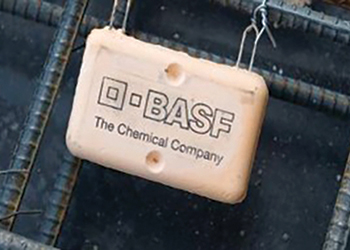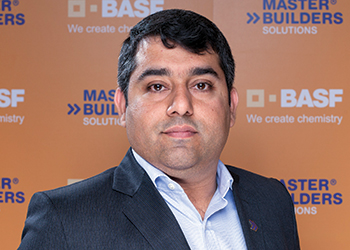BASF offers region top line of defence
01 June 2016
BASF Construction Chemicals has designed admixtures that offer maximum protection against corrosion, says NAVIN SHEWANI, regional product manager, repair, protection and performance grouts.
Given the prevailing urban realities of climate change, excessive energy usage and depletion of valuable and scarce resources, there is little doubt that our infrastructure must be built for long-term endurance.
The longer a structure lasts, the less the resources and OpEx (operating expenditure) required for periodic maintenance and upgrades.
Weather- and damage-resistant buildings reduce the total cost of ownership (TCO) in the long run, thereby enhancing the building’s property value in the market. A solid building with an extended lifecycle decreases future construction costs and the resulting environmental impact and improves safety in the face of natural disasters. Creating a durable structure that contributes to the conservation of energy is important now more than ever before, as we live in an increasingly sustainability-conscious world.
Corrosion is a common environmental factor that significantly damages modern infrastructures. It is a major cause of concrete deterioration across the GCC region. The corrosion process we typically observe in concrete is electrochemical in nature, resulting from the flow of electrons between anodic and cathodic sites on the rebar.
 |
BASF anodes play a vital role in arresting the corrosion process. |
Buildings across the extremely hot and humid GCC region are known to suffer the aggressive impact of corrosion that results from exposure to chlorides at elevated temperatures.
As countries in the region continue to heavily invest in infrastructure projects, building owners, contractors and architects must urgently implement and integrate effective corrosion control methods during construction to effectively enhance structural quality and the lifespan of buildings. By using the right solutions, buildings can still withstand the test of time.
BASF’s Construction Chemicals division offers innovations for new construction, renovation and maintenance of structures under its Master Builders Solutions brand that also includes technologies to avoid the corrosion of steel reinforcement. Its products are customised to the region’s weather conditions and construction needs.
When it comes to following best practices in designing or constructing a structure, it is important to note that the quality of the concrete used is a major factor in the fight against corrosion. Planning for the right concrete mix design is an important step prior to construction. Using the right admixtures for concrete is the next step.
BASF’s MasterLife CI 222 is a state-of-the-art organic migratory corrosion inhibiting admixture that has been formulated to provide two levels of corrosion defence – inhibiting and waterproofing for maximum protection. It extends the service life of reinforced concrete by reducing the rate at which chlorides and moisture enter concrete even while increasing sulphate resistance.
MasterLife CI 222 is combined with a hydrophobic pore-blocking waterproofing mechanism that acts as a barrier to oxygen. It lines the pores of the concrete matrix to drastically slow down the corrosion process in various types of concrete – including precast/prestressed and post-tensioned applications. It can be used in various temperatures and protects reinforcement from corrosion even in cracked concrete.
This easy-to-apply solution does not affect initial slump or workability retention on fresh concrete, nor does it impact setting time. MasterLife CI 222 follows ASTM G109 and ASTM C494 specification standards, and additionally meets the health, safety and environment (HSE) requirements strictly enforced across the range of BASF products and services.
BASF has applied this solution to various structures including parking garages, bridge decks, marine structures, slabs and floors. In the UAE, MasterLife CI 222 has been used for Abu Dhabi’s Al Mafraq Hospital. For this project, the client required a solution that would protect the structure from ground water and chlorides. BASF addressed this need through administering 380,000 litres of the product in the construction phase. The admixture helped consolidate the hospital structure while factoring in long-term environmental safety and sustainability.
 |
Shewani ... protection focus. |
Maintenance challenges
The most common procedure for repairing deteriorated concrete involves the removal of the damaged material and replacement with new concrete or mortar. With sustainable building regulations and practices here to stay, the ‘chip-and-patch’ style of repairs, while effective in the short term, is no longer a feasible option.
BASF offers constructive repair and protection solutions for existing structures. These solutions carefully factor in the differences in pH, porosity, and chloride content that lead to corrosion, instead of implementing a quick-fix technique.
Repair of corrosion-related deterioration in concrete structures presents unique challenges. In particular, the ‘ring anode’ effect, also called the ‘halo’ effect is a phenomenon that is frequently overlooked, although it is a common cause of premature patch failure or increased repair volume. The ring-anode effect describes the increase in corrosion activity adjacent to a repair area and is caused by the electrochemical incompatibility between reinforcing steel within a patch and the steel embedded within the surrounding concrete.
MasterProtect 8065CP and 8105CP are embedded galvanic anodes for the protection of reinforcing steel. These are buried within the concrete during construction, and are typically installed at the perimeter of a repair area so as to be as close as possible to the area of concern. When a compatible MasterEmaco mortar is placed around the anode, it begins to protect the adjacent reinforcement.
Meanwhile, MasterProtect 8000CI is an advanced surface-applied corrosion inhibitor developed with organo-functional silanes. These chemical compounds change the surface tension of the mineral substrates producing a water-repellent surface that protects from water and aggressive water-soluble salts, such as chlorides and sulphates. As a result, the electrochemical cell reactions at the anode and cathode in the steel rebar are inhibited.
The product penetrates deeply into concrete and its micro-cracks, re-passivating the steel rebar after chloride- and carbonation-induced corrosion. MasterProtect 8000CI greatly reduces water and chloride ingress while allowing the concrete to breathe.
Such protection is ideal for exposed structures like bridge decks, piers, columns and beams, car-parks, building facades and balconies, as well as marine jetties and structures.
BASF implemented this solution along the highway connecting Kuwait to the Bubiyan Island (the Bubiyan Sea Port project) in 2012.
BASF Construction Chemicals offers other corrosion control solutions under the MasterProtect range including hydrophobic impregnations based on silane and siloxane technologies. MasterProtect H 1100, for instance, significantly reduces absorption of water. It is capable of blocking alkali/silica reactions in concrete, making it an ideal waterproofing solution for concrete facades, bridges and all marine concrete structures. The range also includes anti-carbonation coatings such as MasterProtect 300, which are based on acrylic co-polymers. When applied as a liquid it cures to form a durable and protective waterproof membrane.
- BASF offers region top line of defence
- Hempaline designed for tough applications
- Carbide coatings curb corrosion: research



